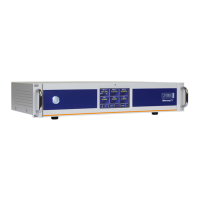MercuryiTC
©2014 Oxford Instruments Omicron NanoScience. All rights reserved.
Page 61
with increasing temperature difference. The iTC contains cold-junction compensation, so a
reference junction is not required.
4.11.2 Metallic resistance thermometers (positive
temperature coefficient)
The resistance of metallic resistors increases with increasing temperature due to the increase of
scattering events of the conduction electrons. Over much of the temperature range the
relationship is approximately linear until, at low temperatures, impurity scattering becomes
significant and the sensor sensitivity flattens off. The iTC passes a constant current through the
sensor and measures the voltage produced, using a 4-wire measurement. Resolution to 1 mK is
possible at low temperatures, if a suitable resistor and energisation current are used.
4.11.3 Semiconductor resistance thermometers (negative
temperature coefficient)
Semiconductor resistance thermometers (negative temperature coefficient)
The resistance of semiconductor resistors decreases with increasing temperature. The
relationship is non-linear. The iTC uses a 4-wire connection, applying a constant voltage across
the resistor. The iTC then measures the current, which is used to calculate the temperature.
The current through the resistor increases with temperature and its relationship to the
temperature is more linear than the resistance of the resistor. Using a constant voltage ensures
that power dissipation in the resistor decreases as the temperature decreases. Resolution to
0.1mK is possible at low temperatures.
4.11.4 Semiconductor diodes
These devices produce a voltage that decreases as the temperature increases. The iTC passes
a constant current through the diode and measures the voltage produced. Resolution to 1mK is
possible at low temperatures.
4.11.5 Excitation current
Resistance and diode sensors require an excitation current. A 4-wire connection is used for
these sensors.

